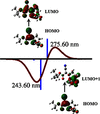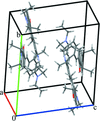issue contents
November 2019 issue

Cover illustration: A new mesogenic compound containing the fluorene moiety exhibits enantiotropic nematic liquid crystalline behaviour with melting at 125 °C and isotropization at 175 °C. The crystallographically independent unit contains two molecules oriented face-to-edge with respect to each other. See Gupta, Choudhury, Dmochowska, Kula, Borbone & Centore [Acta Cryst. (2019), C75, 1459-1464].
research papers


 access
access































 journal menu
journal menu

































